Picture |
Object
name
#NORAD |
Description |
Launch
Date |
Weight |


|
NOAA-20
JPSS-1
#43013
(2017-073A) |
NOAA-20,
designated JPSS-1 prior to launch, is the first of the
United States National Oceanic and Atmospheric Administration's
latest generation of U.S. polar-orbiting, non-geosynchronous,
environmental satellites called the Joint Polar Satellite
System. NOAA-20 was launched on November 18th,
2017 and joined the Suomi National Polar-orbiting Partnership
satellite in the same orbit. NOAA-20 operates about
50 minutes ahead of Suomi NPP, allowing important overlap
in observational coverage.
I am searching
for sound files. Please send them to
 |
Nov. 18th
2017 |
1929 kg |


|
INS-1C
#43116
(2018-004F) |
INS-1C (ISRO
NanoSatellite 1C) is an Indian Nanosatellite developed
by ISRO. It carries a Miniature Multi Spectral Imager
Technology Demonstrator (MMX-TD). Data sent by this
camera is expected to be useful for topographical mapping,
vegetation monitoring, aerosol scattering and cloud
studies. It was launched on January 12th
2018 on PSLV C40 from India. The expected lifetime is
6 months. Data downlink is in S-Band with 1Mbps. Command
and telemetry exchange is handled in VHF and UHF bands.
I am searching
for sound files. Please send them to
 |
Jan
12th 2018 |
11
kg |
On January 15th
2018 Nico Janssen PA0DLO reported a possible reception
of telemetry from INS-1C on 435.085 MHz in 1200 bps
FSK AX.25. This has yet to be finally confirmed. |

|
STEP
Cube Lab
STEP-1
#43138
(2018-004AD) |
STEP Cube Lab
(Space Technology Experimental Project
CubeSat Laboratory) is a 1U
CubeSat mission developed at Chosun University,
Gwangju, South Korea. Its
target is to verify core space technologies researched
in universities and industries, and verifying those
technologies on-orbit. The 1kg cubesat was
launched on January 12th 2018
on PSLV C40 from India into
a 600km sun synchronous orbit. A downlink frequency
of 437.485 MHz has been coordinated. It was reported
that the CW beacon has been received.
I am searching
for sound files. Please send them to
 |
Jan
12th 2018 |
1
kg |
 On July 2nd
2022 at 10:20 UTC Daniel DL7NDR received STEP-1 on 437.478
MHz. Waterfall display of the reception kindly provided
by Daniel DL7NDR. On July 2nd
2022 at 10:20 UTC Daniel DL7NDR received STEP-1 on 437.478
MHz. Waterfall display of the reception kindly provided
by Daniel DL7NDR.
|

|
TianYi
2
TY 2
XiaoXiang 2
XX 2
#43155
(2018-008A) |
TY
2 is a payload in the satellite XiaoXiang 2 (XX 2).
Xiaoxiang 2, also known as Hunan Xiangjiang New Area
satellite or TY 2 (Tianyi 2) was launched on the third
CZ-11 flight in early 2018 into a 500 km sun synchronous
LEO. It carries technology experiments developed by
Tianyi Research Institute in Changsha, Hunan province.
The up- and downlink frequency is 435.350 MHz for 9600
bd GMSK. An additional up- and downlink is at 2403.000
MHz for 5 Mbit/s OFDM. A third downlink is available
at 5833.000 MHz with a corresponding uplink at 5653.000
MHz for 5 Mbit/s OFDM.
I am searching
for sound files. Please send them to
 |
Jan 19th
2018 |
8 kg |

|
TianYi
6
TY 6
QuanTuTong 1
QTT 1
#43158
(2018-008D) |
QTT 1 (Quantutong
1) is a navigation communication integration test satellite
developed by developed by Tianji Research Institute.
QTT-1 is the first technical verification satellite
for the "future constellation programme" which
is customized and developed by Tianyi Research Institute
for for Beijing-based Quan Tu Tong Co (Full Map Network
Co. Ltd.) The satellite is based on the 6U CubeSat satellite
platform of Spacety Aerospace Co. It carries navigation,
communication, imaging, AIS, and amateur radio payloads.
TY 6 is a payload
in the satellite QuanTuTong 1 (QTT 1).
The up- and downlink
frequency is 436.100 MHz for 9600bd GMSK. An additional
up- and downlink is at 2415.000 MHz for 5Mbit/s OFDM.
A third downlink is available at 5845.000 MHz with a
corresponding uplink at 5667.000 MHz for 5Mbit/s OFDM. |
Jan
19th 2018 |
8
kg |
 The 9600bd
FSK downlink of TY-6 on 436.100 MHz was received on
March 6th 2018 at 10:45 UTC
by EA7ADI. Recording kindly provided by Francisco EA7ADI. The 9600bd
FSK downlink of TY-6 on 436.100 MHz was received on
March 6th 2018 at 10:45 UTC
by EA7ADI. Recording kindly provided by Francisco EA7ADI.
|


|
S-Net
#43186
(2018-014x) |
S-Net
is a nanosatellite project of the Technical University
of Berlin to investigate and demonstrate the inter-satellite
communication technology within a distributed an autonomously
operating nanosatellite network. Each of the 3-axis-stabilized
satellites measures 24cmx24cmx24cm and has a weight
of 8kg. The inter-satellite links are in S-Band. The
first 4 S-Net satellites S-Net 1...4 (Tubsat 13...16)
were launched on February 1st
2018 on a Russian Fregat-M rocket.
Tracket objects are 43186, 43187,
43188, 43189.
TLEs for S-Net are not yet published.
Downlink: 435.950
MHz. |
Feb
1st 2018 |
8
kg |
 The 1200bd
FFSK downlink of SNET on 435.950 MHz was received on
April 13th 2018 at 10:30 UTC
by EA7ADI. Recording kindly provided by Francisco EA7ADI. The 1200bd
FFSK downlink of SNET on 435.950 MHz was received on
April 13th 2018 at 10:30 UTC
by EA7ADI. Recording kindly provided by Francisco EA7ADI.
|

|
Tanyusha-3
Radioskaf RS-8
#43597
(1998-067PJ) |
Tanusha-3
transmits on 437.050 MHz. Its FM transmissions include
greetings from students in several languages, including
Russian, English, Spanish and Chinese.
I am searching
for sound files. Please send them to
 |
Feb 13th
2018 |
4.8
kg |
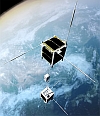 |
STARS-Me
Mother
#43640
(2018-014x) |
Shizuoka
University's STARS-Me (Space Tethered Autonomous Robotic
Satellite - Miniature Elevator) consists of a Mother
Satellite and a Daughter Satellite connected by a tether
and a crawler.
This is the fourth
mission of the STARS series and is constructed to the
2U CubeSat form factor. STARS-Me consists of two 1U
CubeSats having basic functions independently, and each
satellite communicates with the ground station independently.
The two CubeSats are connected by a tether. One of them
is called CV, and the other is called HT and are connected
by a rigid tape tether. CV has a climber and approximately
3 meter tether, and HT has the tether deployment mechanism
consisting of approximately 11 meter tether accounting
to a total of 14 meter tether.
As of October 13th
2018 STARS-Me Daughter is not yet separated from the
Mother satellite and not yet transmitting.
I am searching
for sound files. Please send them to
 |
Sept.
22nd 2018 |
3
kg |
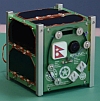


|
Nepalisat-1
JG6YLF
#44331
(1998-067QG) |
NEPALISAT-1
is a small technological CubeSat (1U) built by Kyushu
Institute of Technology (Kyutech) as the Joint Global
Multi-Nation Birds Satellite project, which is a cross-border
interdisciplinary satellite project for non-space faring
countries supported by Japan. Neaplisat-1 is a Cubesat
from Nepal. It is part of the 3rd
batch of such BIRD satellites and was released together
with Uguisu (Japan) and Raavana-1 (Sri Lanka) from the
ISS on June 17th 2019. |
June
17th 2019 |
1
kg |
 The CW
beacon of Nepalisat-1 is using the callsign JG6YLF and
was received on August 11th
2019 at 16:30 UTC during orbit #861 on 437.375 MHz by
Jean-Pierre F5YG. Recording kindly provided by Jean-Pierre
F5YG. The CW
beacon of Nepalisat-1 is using the callsign JG6YLF and
was received on August 11th
2019 at 16:30 UTC during orbit #861 on 437.375 MHz by
Jean-Pierre F5YG. Recording kindly provided by Jean-Pierre
F5YG.
|



|
Raavana-1
JG6YLG
#44329
(1998-067QE) |
Raavana-1
is a small technological CubeSat (1U) built by Kyushu
Institute of Technology (Kyutech) as the Joint Global
Multi-Nation Birds Satellite project, which is a cross-border
interdisciplinary satellite project for non-space faring
countries supported by Japan. Raavana-1 is a Cubesat
from Sri Lanka. It is part of the 3rd
batch of such BIRD satellites and was released together
with Nepalisat-1 (Nepal) and Uguisu (Japan) from the
ISS on June 17th 2019. |
June
17th 2019 |
1
kg |
 The CW
beacon of Raavana-1 is using the callsign JG6YLG and
was received on August 11th
2019 at 14:45 UTC during orbit #860 on 437.375 MHz by
Jean-Pierre F5YG. Recording kindly provided by Jean-Pierre
F5YG. The CW
beacon of Raavana-1 is using the callsign JG6YLG and
was received on August 11th
2019 at 14:45 UTC during orbit #860 on 437.375 MHz by
Jean-Pierre F5YG. Recording kindly provided by Jean-Pierre
F5YG.
|



|
UGUISU
Bird JPN
JG6YLE
#44330
(1998-067QF) |
UGUISU
is a small technological CubeSat (1U) built by Kyushu
Institute of Technology (Kyutech) as the Joint Global
Multi-Nation Birds Satellite project, which is a cross-border
interdisciplinary satellite project for non-space faring
countries supported by Japan. Uguisu is a Cubesat from
Japan. It is part of the 3rd
batch of such BIRD satellites and was released together
with Nepalisat-1 (Nepal) and Raavana-1 (Sri Lanka) from
the ISS on June 17th 2019. |
June
17th 2019 |
1
kg |
 The CW
beacon of UGUISU is using the callsign JG6YLE and was
received on August 10th 2019
at 15:40 UTC during orbit #845 on 437.375 MHz by Jean-Pierre
F5YG. Recording kindly provided by Jean-Pierre F5YG. The CW
beacon of UGUISU is using the callsign JG6YLE and was
received on August 10th 2019
at 15:40 UTC during orbit #845 on 437.375 MHz by Jean-Pierre
F5YG. Recording kindly provided by Jean-Pierre F5YG.
|
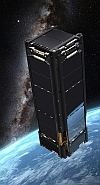


|
LightSail
2
#44420
(2019-036AC) |
The
Planetary Society’s LightSail 2 CubeSat is a citizen-funded
project to send a small spacecraft, propelled solely
by sunlight, into Earth’s orbit. It was launched on
June 25th 2019 as part of the
Prox-1 satellite. It was deployed from the Prox-1 microsatellite
on July2nd 2019 in a higher
orbit to perform its own solar sailing mission. It deployed
its sail on July 23rd 2019.
On August 31st 2019, the Planetary
Society declared the mission a success, as it had raised
the apogee of its orbit by nearly two kilometers in
four days after deployment, while lowering the apogee.
LightSail-2 automatically
transmits on the frequency 437.025 MHz a 9600bd beacon
packet every few seconds, which can be decoded into
238 lines of text telemetry describing the spacecraft’s
health and status, including everything from battery
status to solar sail deployment motor state. In addition
it transmits every 45 seconds a CW signal. |
June
25th 2019 |
|
 Luciano
PY5LF received the 9600bd telemetry from LightSail-2
and the CW beacon "WM9XPA" on August 1st
2019 at 15:45 UTC on 437.023 MHz in USB. Recording kindly
provided by Luciano PA5LF. Luciano
PY5LF received the 9600bd telemetry from LightSail-2
and the CW beacon "WM9XPA" on August 1st
2019 at 15:45 UTC on 437.023 MHz in USB. Recording kindly
provided by Luciano PA5LF.
|
  Roland
PY4ZBZ received the CW beacon of Lightsail-2 at 437.025
MHz on April 6th 2020 at 18:45
UTC. Recording and RF as well as audion spectrum Roland
PY4ZBZ received the CW beacon of Lightsail-2 at 437.025
MHz on April 6th 2020 at 18:45
UTC. Recording and RF as well as audion spectrum  plots
kindly provided by Roland PY4ZBZ. plots
kindly provided by Roland PY4ZBZ.
|

|
Painani-1
#44365
(2019-0xxx) |
Painani 1 is an
experimental nanosatellite owned by Secretaría
de la Defensa Nacional (SEDENA), the Mexican defence
agency, and developed by the Universidad del Ejerito
y Fuerza Aerea.
It is a 3U CubeSat
and carries four small low resolution cameras as a technology
experiment, which are only operated over Mexican territory.
The data will be downlinked by an S-band downlink using
frequency hopping technology. The purpose of the mission
is to enable students of the Ensenada Centre for Scientfic
and Higher Education to experiment on improving digital
signal processing and Earth station software.
It was launched
as an undisclosed commercial payload launched on a shared
launch on an Electron KS in June 2019 from New Zealand,
and was onyl identfied several weeks later by the New
Zealand Space Angency.
Painani-1 decayed on January 14th
2024. |
June
29th 2019 |
3.3
kg |
 On October
3rd 2022 at 11:21 UTC Daniel
DL7NDR received on 437.475 MHz the 9600bd FSK beacon.
Recording kindly provided by Daniel DL7NDR. On October
3rd 2022 at 11:21 UTC Daniel
DL7NDR received on 437.475 MHz the 9600bd FSK beacon.
Recording kindly provided by Daniel DL7NDR.
|



|
Meteor
M2-2
#44387
(2019-038A) |
Meteor M2-2 is a russian weather satellite
in a 815km high low circular orbit.
Here are the
downlink frequencies:
APT 137.150
MHz RHCP
APT 137.850
MHz RHCP
LRPT 137.100 MHz RHCP
LRPT 137.900 MHz RHCP
AHRPT 1700
MHz RHCP
AHRPT 1705 MHzRHCP
DA 8128
MHz LHCL
DA 8320
MHz LHCP |
July
5th 2019 |
2700
kg |
  The
LRPT downlink signal at 137.100 MHz was received on
July 9th 2019 at 09:20 UTC
by Egor UB1QBJ, when the satellite flew over Russia.
At that time the satellite was still in commissioning
phase and thus no data was sent. Egor also received
the HRPT downlink signal at 1700 MHz, The
LRPT downlink signal at 137.100 MHz was received on
July 9th 2019 at 09:20 UTC
by Egor UB1QBJ, when the satellite flew over Russia.
At that time the satellite was still in commissioning
phase and thus no data was sent. Egor also received
the HRPT downlink signal at 1700 MHz,  which
was also not yet transmitting useful data. Recording
and spectrum plots kindly provided by Egor UB1QBJ. which
was also not yet transmitting useful data. Recording
and spectrum plots kindly provided by Egor UB1QBJ.
|
 On
January 6th 2020 Egor also
received the HRPT downlink of Meteor M2-2 during its
regular transmissions. Spectrum plot kindly provided
by Egor UB1QBJ. On
January 6th 2020 Egor also
received the HRPT downlink of Meteor M2-2 during its
regular transmissions. Spectrum plot kindly provided
by Egor UB1QBJ.
|

|
Lucky-7
OK0SAT
#44406
(2019-038W) |
Lucky-7 is a Czech
1U-CubeSat mission built by SkyFox Labs for technology
demonstration.
To prove the subsystems
in harsh environment, the retrograde Sun Synchronous
Orbit at an altitude of 600 km passing through radiation
belts was defined as a target. The satellite will contain
MOSFET-Free Ultra High Efficient radiation tolerant
switch mode low voltage power supply, cold redundant
onboard computer with cold redundant UHF transceivers,
cold redundant zero deployment torque dipole antennas,
active Attitude Determination and Control Subsystem
with special custom-made Ultra Low Power GPS-L1 navigation
receiver and a set of high power LEDs transmitting in
visible spectra (blue) to demonstrate EPS high power
handling capability. Among those listed above the Digital
Color camera module will be used aboard the satellite
to capture the images of Earth to confirm ADCS stabilization
functionality and “high” data transfer throughput capability
of the custom-built FSK onboard radio. |
July
5th 2019 |
1
kg |
 On October
31st 2022 at 14:38 UTC Daniel
DL7NDR received on 437.525 MHz the 4800bd GFSK beacon.
Recording kindly provided by Daniel DL7NDR. On October
31st 2022 at 14:38 UTC Daniel
DL7NDR received on 437.525 MHz the 4800bd GFSK beacon.
Recording kindly provided by Daniel DL7NDR.
|


|
JAISAT-1
JAISAT
#44419
(2019-038F) |
JAISAT
was developed by German Orbital Systems for RAIS, the
Radio Amateur Society of Thailand. It was launched together
with Meteor M2-2.
It transmits on
435.700 Mhz in FM. |
July
5th 2019 |
~4
kg |
 On December
25th 2022 at 14:55 UTC Daniel
DL7NDR received on 435.700 MHz the 4800bd MOBITEX beacon.
Recording kindly provided by Daniel DL7NDR. On December
25th 2022 at 14:55 UTC Daniel
DL7NDR received on 435.700 MHz the 4800bd MOBITEX beacon.
Recording kindly provided by Daniel DL7NDR.
|
 |
EXOCONNECT
D-STAR ONE
#44410
(2019-038AA) |
EXOCONNECT
was developed by German Orbital Systems. It was launched
together with Meteor M2-2.
It transmits on
435.700 Mhz in FM (4k8 9k6 MOBITEX).
I am searching
for sound files. Please send them to  |
July 5th
2019 |
4 kg |
 |
LightSat
D-STAR ONE
#44393
(2019-038H) |
LightSat
is a 3U Cubesat developed by German Orbital Systems.
It was launched together with Meteor M2-2.
It
transmits on 435.700 MHz in FM (4k8 9k6 MOBITEX)
Lightsat
decayed on June 6th
2024. |
July
5th 2019 |
4
kg |
 On May
18th 2023 around 14:55 UTC
Daniel DL7NDR received on 435.700 MHz the 4800bd GMSK
MOBITEX transmission. Recording kindly provided by Daniel
DL7NDR. On May
18th 2023 around 14:55 UTC
Daniel DL7NDR received on 435.700 MHz the 4800bd GMSK
MOBITEX transmission. Recording kindly provided by Daniel
DL7NDR.
|
 |
Lemur
2
100-107
#4364x
(2019-038x) |
Lemur-2 is the initial
constellation of low-Earth orbiting satellites built
by Spire. These satellites carry payloads for meteorology,
the STRATOS GPS radio occultation experiment, the SENSE
AIS-receiver for ship traffic tracking and the AirSafe
ADS-B payload.
Together
with Meteor M2-2 seven LEMUR-2 satellites (#100...#107)
were launched.
I am searching
for sound files. Please send them to  |
July 5th
2019 |
4 kg |


|
Sokrat
#44404
(2019-038U) |
Sokrat
was developed by the MSU's Skobeltsyn Institute of Nuclear
Physics (SNIP) in Moscow/Russia. The 3U cubesat was
launched together with Meteor M2-2. It carries particle
and gamma ray detectors to study space weather.
It transmits on
436.000 MHz in FM (4k8 MOBITEX)a and DSTAR |
July
5th 2019 |
xxx
kg |
 PY4ZBZ
received the DSTAR downlink Sokrat on January 13th
2020. Recording kindly provided by Roland PY4ZBZ. PY4ZBZ
received the DSTAR downlink Sokrat on January 13th
2020. Recording kindly provided by Roland PY4ZBZ.
|
 On October
1st 2022 at 15:01 UTC Daniel
DL7NDR received on 436.000 MHz the 4800bd MOBITEX transmission.
Recording kindly provided by Daniel DL7NDR. On October
1st 2022 at 15:01 UTC Daniel
DL7NDR received on 436.000 MHz the 4800bd MOBITEX transmission.
Recording kindly provided by Daniel DL7NDR.
|
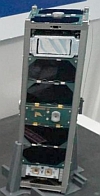
 |
AmurSat
AmGU-1
#44394
(2019-038J) |
AmurSat,
which is also known as AmGU-1, carries the Foton-Amur
instrument consisting of charged particle and gamma
ray detectors to study space weather phenomena. It was
developed by Amur State University, in conjunction with
the Institute of Nuclear Physics at Moscow State University
(MSU). It was launched together with Meteor M2-2.
It transmits on
436.250 MHz in FM (4k8 MOBITEX). |
July
5th 2019 |
xxx
kg |
 On October
3rd 2022 at 14:15 UTC Daniel
DL7NDR received on 436.250 MHz the 4800bd MOBITEX transmission.
Recording kindly provided by Daniel DL7NDR. On October
3rd 2022 at 14:15 UTC Daniel
DL7NDR received on 436.250 MHz the 4800bd MOBITEX transmission.
Recording kindly provided by Daniel DL7NDR.
|

 |
VDNH-80
VDNKh-80
#44392
(2019-038G) |
VDNH-80
was built by MSU's Institute of Nuclear Physics in conjunction
with JSC VDNH and also carries charged particle detectors.
As well as studying space weather, the satellites will
also fulfill technology development and demonstration
objectives. It was launched together with Meteor M2-2.
It transmits on
436.500 MHz in FM (4k8 MOBITEX). |
July
5th 2019 |
3
kg |
 On October
8th 2022 at 14:39 UTC Daniel
DL7NDR received on 436.5000 MHz the 4800bd MOBITEX transmission.
Recording kindly provided by Daniel DL7NDR. On October
8th 2022 at 14:39 UTC Daniel
DL7NDR received on 436.5000 MHz the 4800bd MOBITEX transmission.
Recording kindly provided by Daniel DL7NDR.
|
 |
UTE-Ecuador
#4364x
(2019-038xxx) |
UTE-Ecuador
is a space weather and ionospheric research mission
being carried out by the Universidad Tecnológica
Equinoccial (UTE) of Ecuador using a three-unit CubeSat.
It was launched together with Meteor M2-2.
It transmits on
437.050 MHz in FM (CW, TEXT 1k2 AX.25, TLM 1k2 2k4 4k8
9k6 GMSK, FM Voice, SSTV BW12)
I am searching
for sound files. Please send them to  |
July 5th
2019 |
4 kg |


|
OPS-SAT
#44878
(2019-092F) |
OPS-SAT
is a 3U CubeSat for the European Space Agency (ESA)
European Space Operations Center (ESOC) that will allow
on-orbit testing and demonstration of experimental and
innovative software that may be used in future ESA missions
and programs.
The UHF downlink
frequency is 437.200 MHz using 9600 bd GMSK with a bandwidth
of 25kHz. |
Dec
18th 2019 |
4.6
kg |
 On January
25th 2023 at 17:35 UTC Daniel
DL7NDR received on 437.200 MHz the 9600bd GFSK beacon.
Recording kindly provided by Daniel DL7NDR. On January
25th 2023 at 17:35 UTC Daniel
DL7NDR received on 437.200 MHz the 9600bd GFSK beacon.
Recording kindly provided by Daniel DL7NDR.
|
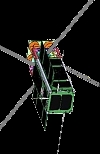
|
SWAMPSAT-2
#45115
(2019-071E) |
SwampSat
II is a 3U Cubesat built by the University of Florida,
USA. One of the mission goals is to test a boom and
antenna spooling and deployment mechanism to support
a matched very low frequency (VLF, 3...30kHz) antenna.
It was launched
on November 2nd 2019 by Cygnus
NG-12 from Mid-Atlantic Regional Spaceport Launch Pad
0 on Wallops Island, Virginia to low earth orbit. It
was released from Cygnus on January 31st
2020 and started its operations shortly after.
SwampSat 2 transmits on 436.3493
MHz.
I am searching for sound files. Please
send them to
 |
Nov. 2nd
2019 |
3 kg ? |


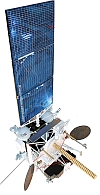
|
Elektro-L3
Electro-L N3
#44903
(2019-095A) |
Elektro-L3
is a Russian Weather satellite built by Roskosmos. It
was launched on a Proton rocket from Baikonur into a
geostationary orbit on 76 degree East. Its main purpose
is to provide weather pictures from Asia, Middle East
and the Indian Ocean featuring 3 visual and 7 infrared
cameras. The resolution of the visual cameras are 1km/pixel
and 4km/pixed of the infrared cameras. The sensor data
is transmitted to Earth in X-band with data rates between
2.56 and 15.36 Mbit/s. Electro-L3 also supports the
COSPAS-SARSAT-system with a downlink at 1.54 GHz (4
Watts). In addition Elektro collects data from ground
stations on 400 MHz and LEOs on 470 MHz and transmits
them back to Earth on 1.7 GHz. Finally Elektro-L N3
features a LRIT downlink signal at 1691 MHz.
I am searching for sound files. Please
send them to
 |
Dec. 24th
2019 |
1700 kg |

|
BY70-2
Xibaipo
#45857
(2020-042B) |
BY70-2 is a 2U-CubeSat
project led by China Center for Aerospace Science and
Technology International Communications for school education
and amateur radio. The amateur radio station onboard
will provide telecommand, telemetry and FM repeater
functions. 3 axis stabilized and have deployable solar
panels.
BY70-2 decayed on August 19th
2024. |
July
3rd 2020 |
2
kg |
 On November
17th 2022 at 21:35 UTC Daniel
DL7NDR received on 436.200 MHz the 9600bd BPSK beacon.
Recording kindly provided by Daniel DL7NDR. On November
17th 2022 at 21:35 UTC Daniel
DL7NDR received on 436.200 MHz the 9600bd BPSK beacon.
Recording kindly provided by Daniel DL7NDR.
|


|
ION-MK01
ION-mk01
#46274
(2020-061C) |
D-Orbit is flying
an extensive and long-term series of Satellite Carrier
Vessel missions based on the ION platform, a low-cost,
responsive, modular, and redundant small satellite platform.
The first iteration
of the ION platform, called ION-mk01, was launched in
September 2020 with the SCV-001 mission. The ION-mk01
platform was loaded with 12 satellites and two other
customers' payloads. The platform successfully transported
and precisely delivered CubeSats from different customers
(the maximum platform capacity was 48U in volume). After
successfully completing its primary deployment mission,
it continues to operate in an extended-operation mode. |
Sept.
3rd 2020 |
xx
kg |
 On November
23rd 2022 at 10:17 UTC Daniel
DL7NDR received on 437.515 MHz the 1200bd FSK beacon.
Recording kindly provided by Daniel DL7NDR. On November
23rd 2022 at 10:17 UTC Daniel
DL7NDR received on 437.515 MHz the 1200bd FSK beacon.
Recording kindly provided by Daniel DL7NDR.
|

|
UPMSAT-2
#46276
(2020-061E) |
UPMSat 2 (Universidad
Politécnica de Madrid Satellite 2) is an educational,
scientific and in-orbit technological demonstration
satellite built by the Technical University of Madrid
– Universidad Politecnica de Madrid (UPM). Its
prime objective is to give students the competences
for designing, building, testing, integrating, and operating
a small satellite, but whose execution involves all
the complexity of a complete space system.
The platform has
a volume of 50cm x 50cm x 60cm, of which about 40% are
available for payloads, and a total mass of about 50
kg. UPMSat-2 operates in a sun-synchronous orbit at
600 km. |
Sept.
3rd 2020 |
50
kg |
 On October
22nd 2022 at 10:22 UTC Daniel
DL7NDR received on 437.405 MHz the 1200bd FSK beacon.
Recording kindly provided by Daniel DL7NDR. On October
22nd 2022 at 10:22 UTC Daniel
DL7NDR received on 437.405 MHz the 1200bd FSK beacon.
Recording kindly provided by Daniel DL7NDR.
|

|
AMICAL-SAT
#46287
(2020-061R) |
AMICal-Sat is a
French 2U-CubeSat designed by CSUG-IPAG (Univ. Grenoble
Alpes) in cooperation with the Moscow State University
to take pictures of the Northern light in order to reconstruct
the particle precipitation into the polar atmosphere.
It was launched on Sept. 3rd 2020 on a Vega rocket from
Kourou/French Guiana.
AMICALSAT transmits a beacon
and telemetry on 436.100 MHz and high speed data with
1Mbps GFSK on 2415.3 MHz. The high speed download is
only active over Russia or in other regions on demand. |
Sept.
3rd 2020 |
2
kg |
  On
June 6th 2021 at 09:40:34 UTC
DD1US received a short burst signal coming from AMICAL-SAT.
There was planned to have a 3-5 minute long transmission
of a picture with 1Mbps but due to a power problem the
transmitter failed. The receive frequency was 2414.960
MHz. An I/Q file of the recording is available on request. On
June 6th 2021 at 09:40:34 UTC
DD1US received a short burst signal coming from AMICAL-SAT.
There was planned to have a 3-5 minute long transmission
of a picture with 1Mbps but due to a power problem the
transmitter failed. The receive frequency was 2414.960
MHz. An I/Q file of the recording is available on request.
|


|
Simba
Sun-Earth-Imbalance
#46279
(2020-061H) |
SIMBA (Sun-Earth
Imbalance), a 3U CubeSat mission led by the Royal Meteorological
Institute Belgium. The objective is to measure the TSI
(Total Solar Irradiance) and Earth Radiation Budget
climate variables with a miniaturized radiometer instrument.
This mission will help in the study of the global warming.
This science mission will have a design lifetime of
3 years and the satellite performances will be monitored
from ground station located in The Netherlands.
SIMBA is not to
be confused with the Italy-Kenyan animal monitoring
satellite #47941 |
Sept.
3rd 2020 |
3
kg |
 On September
4th 2022 at 11:16 UTC Daniel
DL7NDR received on 435.310 MHz the 1200bd GMSK beacon.
Recording kindly provided by Daniel DL7NDR. On September
4th 2022 at 11:16 UTC Daniel
DL7NDR received on 435.310 MHz the 1200bd GMSK beacon.
Recording kindly provided by Daniel DL7NDR.
|

|
TTÜ100
TTÜSat
MektorySAT 1
Hämarik
Koit
#46312
(2020-061AS) |
TTÜ100
is an educational 1U-CubeSat developed at the Tallin
University of Technology. It was launched together with
Meteor M2-2. The mission objective is to test earth
observation cameras and high-speed X-band communications.
It will perform remote sensing in visible and IR electromagnetic
spectrum. TTÜ100 will use the amateur 10.450 –
10.500 GHz band frequencies for high-speed data downlink
operations. |
Sept.
3rd 2020 |
1
kg |
 On September
8th 2023 around 10:15 UTC Daniel
DL7NDR received on 435.450 MHz the 9600bd FSK beacon.
Recording kindly provided by Daniel DL7NDR. On September
8th 2023 around 10:15 UTC Daniel
DL7NDR received on 435.450 MHz the 9600bd FSK beacon.
Recording kindly provided by Daniel DL7NDR.
|

|
Norbi
Norby
#46494
(2020-068J) |
Norbi (also transcribed
Norby) is a Russian 6U CubeSat built by the Novosibirsk
State University. It includes charged particle and gamma
ray detectors to study space weather phenomena.
This satellite is
reported to be transmitting at an uncoordinated or denied
frequency. |
Sept.
28th 2020 |
~6
kg |
 On September
25th 2022 at 12:49 UTC Daniel
DL7NDR received on 436.700 MHz the 9600bd FSK beacon.
Recording kindly provided by Daniel DL7NDR. On September
25th 2022 at 12:49 UTC Daniel
DL7NDR received on 436.700 MHz the 9600bd FSK beacon.
Recording kindly provided by Daniel DL7NDR.
|

|
NetSat-2
#46507
(2020-068X) |
The Würzburg
Zentrum für Telematik's (ZfT) NetSat is an experimental
constellation of four 3U CubeSat class satellites developing
techniques for formation flying using distributed computing
capabilities.
Additionally NetSat
will provide a digipeater service in the 70 cm band
which is open to all radio amateurs. Furthermore, the
satellite gives students at the University of Würzburg
hands-on experience in satellite technology. They are
given the opportunity to participate in the whole mission
from development and assembly of the satellite to in-orbit
operations. After launch, the students will be able
to learn how to communicate with the satellite and operate
it via the ground station located at the Institute of
Computer Science in Wuerzburg/Germany.. |
Sept.
28th 2020 |
4
kg |
 On November
27th 2022 at 12:30 UTC Daniel
DL7NDR received on 435.600 MHz the 9600bd FSK beacon.
Recording kindly provided by Daniel DL7NDR. On November
27th 2022 at 12:30 UTC Daniel
DL7NDR received on 435.600 MHz the 9600bd FSK beacon.
Recording kindly provided by Daniel DL7NDR.
|

|
CAPE-3
CAPE III
#47309
(2021-002A) |
CAPE 3 (Cajun Advanced
Picosat Experiment 3) is the third satellite developed
at the University of Louisiana at Lafayette.
The Cajun Advanced
Picosatellite Experiment (CAPE-3) is an educational
mission that will fly the Smartphone CubeSat Classroom,
which allows anyone with a smartphone to set up a ground
station with a kit. Interactive educational activities
will give students the ability to interact with the
CubeSat via an app on their smartphone and use their
smartphone to design their own CubeSat experiments.
CAPE-3 decayed on
February 21st 2024. |
Jan.
17th 2021 |
1.3
kg |
 On October
31st 2022 at 12:30 UTC Daniel
DL7NDR received on 437.325 MHz the 1200bd AFSK beacon.
Recording kindly provided by Daniel DL7NDR. On October
31st 2022 at 12:30 UTC Daniel
DL7NDR received on 437.325 MHz the 1200bd AFSK beacon.
Recording kindly provided by Daniel DL7NDR.
|


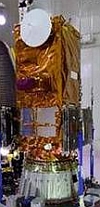
|
AMAZONIA-1
#47699
(2021-15A) |
Amazonia-1
is a brazilian Earth observation satellite. It was launched
on an Indian PSLV-DL rocket. Amazonia-1 carries an optical
instrument called AWFI, operating in the visible and
near infrared band, with a spatial resolution of 40 meters
and a swath of around 780 km. In addition, it includes
the English Camera RALCAM-3, with a resolution in the
order of 10 m, which will complement the images
collected by AWFI.
S-band downlink at 2208 MHz with
a bandwidth of about 300kHz was successfully received.
Probably the X-band downlink is at
8300 MHz.
I am searching for sound files. Please
send them to
 |
Feb. 28th
2021 |
637 kg |





|
ARKTIKA-M
1
#47719
(2021-16A) |
ARKTIKA-M
1 was launched on the Soyuz-2.1b rocket from Baikonur
Cosmodrome in Kazakhstan into a highly elliptical Molniya
orbit with an inclination of 63.3 degree, an apogee
of about 40000km and a perigee of about 1000km. It is
the first of 3 planned satellites which will obtain
color images of clouds and Earth's surface in
the Arctic. The ARKTIKA-M satellites also host receivers
and transmitters to relay information from weather stations
and search and rescue beacons in polar regions.
The following downlink frequencies
have been reported:
1698 MHz with a bandwidth of 2 MHz
(most likely for weather satellite pictures downlink)
1703 MHz with a bandwidth of 54 kHz
(most likely for telemetry)
1544.5 MHz with a bandwidth of 180
kHz (most likely for SARSat)
I am searching for sound files.
Please send them to
 |
Feb. 28th
2021 |
2100 kg |

|
GRBAlpha
1
OM9GRB
#47959
(2021-022AD) |
GRBAlpha (OM9GRB)
is a 1U cubesat and the older brother of GRBBeta. GRBAlpha
was launched on March 22nd 2021 on board a Soyuz-2.1a
from the Baikonur Cosmodrome.
It weighs approximately
1.2 kg and was developed and built by an international
collaboration led by the Technical University of Kosice
in Slovakia, in partnership with the Slovak company
Spacemanic, the Institute of Experimental Physics (IEP)
in Kosice, and several other scientific and educational
institutions.
The main mission
of GRBAlpha is to detect and study gamma-ray bursts
(GRBs). It aims to test new GRB detection technologies
in small cubesat's and contribute to the observation
and study of these explosions in the universe. It also
serves as a precursor to future GRB monitoring satellites.
The following downlink frequency
has been reported: 437.025
MHz in GFSK G3RUH 9k6 + CW. |
Mar.
22nd 2021 |
1.2
kg |
 On October
8th 2023 around 09:15 UTC Daniel
DL7NDR received on 437.025 MHz the 9600bd GFSK beacon. On October
8th 2023 around 09:15 UTC Daniel
DL7NDR received on 437.025 MHz the 9600bd GFSK beacon.
Recording kindly provided by Daniel
DL7NDR. |

|
KSU-Cubesat
#47954
(2021-022Y) |
KSU-Cubesat (King
Saud University Cubesat) is a 1U CubeSat, which was
developed by students and researchers of the College
of engineering (COE) at King Saud University, Saudi
Arabia.
It is the first
Cubesat from Saudi Arabia. Its purpose is to send telemetry
and images taken by a small camera from space and to
repeat received voice messages. |
Mar.
22nd 2021 |
1kg |
 On November
2nd 2023 at 21:52 UTC Daniel
DL7NDR received on 437.130 MHz the 4800bd FSK beacon. On November
2nd 2023 at 21:52 UTC Daniel
DL7NDR received on 437.130 MHz the 4800bd FSK beacon.
Recording kindly provided by Daniel
DL7NDR. |



|
Orbicraft-Zorkiy
RS15S
#47960
(2021-022AE) |
Orbicraft-Zorkiy
(RS15S) is a 6U cubsat with Earth's remote sensing main
mission with its main camera featuring a spatial resolution
of 6.6 meters per pixel manufactured by the Lepton Research
and Production Association (NPO Lepton).
The main experiments
are:
- ERS
RPA Lepton camera (6.6 meters per px)
- Two
cameras with wide angle lens
- Basic payload board
SXC-MBB-06
- A
higher precision solar sensor manufactured by SPUTNIX
RS15S was launched
on March 22nd 2021
along with more than 37 other satellites by a Soyuz-2.1a
at 06:07UTC from the Baikonur Cosmodrome. Currently
the satellite is positioned in an orbit with 97.5 degrees
of inclination and perigee of 480 km.
Orbicraft-Zorkiy
transmits on the following frequencies :
- 437.850
MHz 2k4, 4k8, 9k6 GMSK USP & SSTV
- 437.950
MHz 9k6 GMSK USP
- 10465.000 MHz QPSK/8PSK/16APSK/32APSK
DVB-S2 |
Mar.
22nd 2021 |
8.5kg |
 On September
17th 2022 at 09:59 UTC Daniel
DL7NDR received on 437.850 MHz the 4800bd GMSK beacon. On September
17th 2022 at 09:59 UTC Daniel
DL7NDR received on 437.850 MHz the 4800bd GMSK beacon.
Recording kindly provided by Daniel
DL7NDR. |
  During one of the
SSTV events which took place from May 7th 2023
to May 13th 2023
Igor PU4ELT was able to receive and decode 3 SSTV images.
He received attached SSTV image of the Moon on May 8th 2023
at 02:30 UTC in Robot 72 format on 437.850 MHz. During one of the
SSTV events which took place from May 7th 2023
to May 13th 2023
Igor PU4ELT was able to receive and decode 3 SSTV images.
He received attached SSTV image of the Moon on May 8th 2023
at 02:30 UTC in Robot 72 format on 437.850 MHz.
Recording and image
kindly provided by Igor PU4ELT. |

|
RAMSAT
#48850
(1998-067SL) |
RamSat is a 2U CubeSat
education mission by the Robertsville Middle School
in Oak Ridge (Oak Ridge Public Schools), Tennessee,
to develop and implement a middle school STEM curriculum
for building a CubeSat.
The satellite will
use a small camera to try to take pictures of forest
regrowth in the Great Smoky Mountains near Gatlinburg.
That area burned in forest fires fed by high winds after
Thanksgiving 2016, killing 14 people and damaging or
destroying more than 2,500 homes and businesses. |
June
3rd 2021 |
2kg |
 On May
21st 2022 at 15:50 UTC Daniel
DL7NDR received on 436.300 MHz the 9600bps GMSK beacon
of RAMSAT. Recording kindly provided by Daniel DL7NDR. On May
21st 2022 at 15:50 UTC Daniel
DL7NDR received on 436.300 MHz the 9600bps GMSK beacon
of RAMSAT. Recording kindly provided by Daniel DL7NDR.
|

|
TUBIN
TUBSAT 27
2BIN
TWOBIN
#48900
(2021-059X) |
TUBIN (TU Berlin
Infrared Nanosatellite) is a nanosatellite project of
the Technical University of Berlin / Germany to observe
the earth in infrared. Its size is 31cm x 47cm x 47cm
and his weight is 22.5kg. The mission is to
test an thermal infrared (TIR) earth observation payload
using a micro-bolometer array on a TUBiX20 nanosatellite
bus of TechnoSat heritage. Since power and
size limitations prove prohibitive to accommodating
cooled HgCdTe infrared detectors on a nanosatellite,
TUBIN will carry two uncooled microbolometer imagers.
The cameras are used for determination of sea surface
temperature and land surfaces brightness temperature.
In addition, a third imager with sensitivity in the
visible spectrum will complement the infrared payload.
The ground resolution of the thermal images will be
170 m and the sensitivity 1.5 K. Due to the much smaller
pixel size, the images of the visible spectrum camera
will have a ground resolution of 40 m.
TUBSAT-27 was launched
on June 30th 2024
from Cape Canaveral / USA on a FALCON 9 rocket into
it s 530kg circular orbit. |
June
30th 2021 |
22.5kg |
 On December
18th 2022 at 13:48 UTC Daniel
DL7NDR received on 435.950 MHz the CW beacon of TUBIN
which was using the same callsign DP0TBA as previously
used by Technosat. Recording kindly provided by Daniel
DL7NDR. On December
18th 2022 at 13:48 UTC Daniel
DL7NDR received on 435.950 MHz the CW beacon of TUBIN
which was using the same callsign DP0TBA as previously
used by Technosat. Recording kindly provided by Daniel
DL7NDR.
|


|
LEDSAT
#49069
(2021-073D) |
LEDsat is a 1U Cubesat
developed by students at Sapienza University of Rome.
The mission is designed to investigate the performance
of Light Emitting Diodes as a way of tracking satellites
in low Earth orbit. ESA selected the LEDSat mission
for a rideshare launch opportunity through the agency’s
“Flight Your Satellite!” educational program.
LEDSAT-1 is transmitting
on 435.190 MHz GMSK with 1200, 2400 or 9600 bps. |
Aug.
17th 2021 |
1
kg |
 On December
6th 2022 at 21:25 UTC Daniel
DL7NDR received on 435.190 MHz the 9600bd GMSK beacon.
Recording kindly provided by Daniel DL7NDR. On December
6th 2022 at 21:25 UTC Daniel
DL7NDR received on 435.190 MHz the 9600bd GMSK beacon.
Recording kindly provided by Daniel DL7NDR.
|
 On December
28th 2022 at 10:35 UTC Daniel
DL7NDR received on 435.190 MHz the 1200bd GMSK beacon.
Recording kindly provided by Daniel DL7NDR. On December
28th 2022 at 10:35 UTC Daniel
DL7NDR received on 435.190 MHz the 1200bd GMSK beacon.
Recording kindly provided by Daniel DL7NDR.
|



|
KOSEN-1
JR5YGJ
#49402
(2021-102H) |
KOSEN 1
is
a 2U CubeSat satellite built by the Kochi National College
of Technology intended to be used for radio observation
of Jupiter. This CubeSat was specially designed to be
very precise in its orientation, equipped with two ultra-thin
reaction wheels, as well as a new software system. It
will deploy a 6.6 m long antenna to study Jupiter bursts
in the 21 MHz band.
KOSEN-1
is supposed to receive also Morse CW signals in 21 MHz
band with the onboard SDR transmit the decoded
call signs on its 435 MHz downlink. However there have
been not reports that this has happened. |
Nov.
9th 2021 |
3
kg |
  The CW
beacon of KOSEN-1 using the callsign JR5YGN was received
and decoded on April 26th 2024
at 23:43UTC on 435.525Mhz by Igor PU4ELT. The CW
beacon of KOSEN-1 using the callsign JR5YGN was received
and decoded on April 26th 2024
at 23:43UTC on 435.525Mhz by Igor PU4ELT.
Recording kindly provided by
Igor PU4ELT. |

|
Light-1
RAADSAT
#51509
(1998-067TG) |
Light 1, formerly
known as RAADsat is an 3U CubeSat earth observation
mission to Terrestrial Gamma-ray Flashes (TGFs), upward
directed bursts of X-rays and gamma-rays associated
with thunderstorm activity. The mission is being developed
by a collaboration between UAE SA (United Arab Emirates
Space Agency), Khalifa University and NYUAD.
The mission is based
on an original detector design being developed at New
York University Abu Dhabi (NYUAD).
The satellite was
launched onboard the Dragon CRS-24 cargo spacecraft
to the ISS Dec. 21st 2021
, from where it was deployed February 3rd 2022. |
Dec.
21st 2021 |
~4
kg |
 On November
3rd 2022 at 21:35 UTC Daniel
DL7NDR received on 437.710 MHz the 2400bd FSK beacon.
Recording kindly provided by Daniel DL7NDR. On November
3rd 2022 at 21:35 UTC Daniel
DL7NDR received on 437.710 MHz the 2400bd FSK beacon.
Recording kindly provided by Daniel DL7NDR.
|
Picture |
Object
name
#NORAD |
Description |
Launch
Date |
Weight |